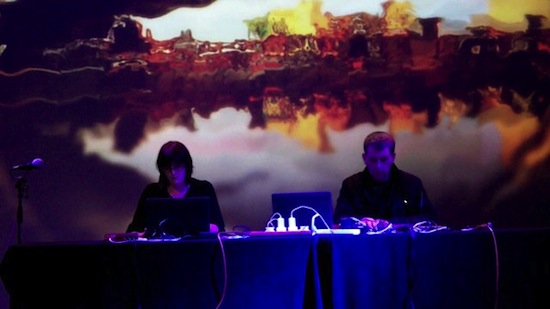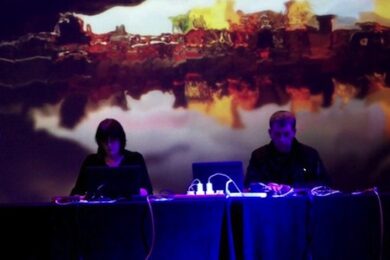Salford Sonic Fusion Festival is a magnificent event. By all (independent) accounts it’s been dragged back from the brink of irrelevance to become one Europe’s most engaging celebrations of electronic music and sound that takes in both the club and the performance space, not to mention the arts, acoustics and philosophy departments and the great outdoors. I have this on good authority, and even though I cannot attest to what it was like several years ago, I do know how good it is now. Later in the weekend I will visit the Acoustics Department at the Peel Campus of the University to experience Mark Fell’s moving (in several senses) 64 Beautiful Phase Violations – an experiment on space and sound in an anechoic chamber. (There will be a feature on Fell and his work later this month on the Quietus.) While waiting to experience his installation, I spend a pleasant hour chatting with staff and students at the department and visiting other functional spaces such as the uncanny Reverberation Room. Among the many things that I am told (most of the staff prefer to listen to either nu-metal or shoegaze on a Friday afternoon when they get back from the pub) is that the chamber Fell in which has assembled his ring of 64 oscillators, is known as Europe’s quietest room.
This is worth mentioning, because I would guess that the University Campus, where tonight’s Harmonic Coaction takes place, contains some of the quietest rooms in Greater Manchester, anechoic or not. My companion at the event, the inimitable John Tatlock, a Quietus writer but also a sound engineer and producer by trade, points out the actual audio quality of the rooms we visit. There is nary a hiss, hum, rattle, whistle or crackle. The room of tonight’s performance goes from dead silence to vibrant crystal waves at the push of a square. Friend of the Quietus, the music writer Louis Pattison, often self-deprecatingly (and presumably not seriously) refers to the abstract electronic noise music he buys as "expensive static" – tonight’s room exhibits all the hallmarks of expensive silence. Perhaps this is to be expected from a university campus based in such benevolently futuristic surroundings as the new Salford Quays renewal project, and it’s a joy to visit this Parallax-View-gone-right side of town; the ridiculous new name of Media City UK notwithstanding.
Holly Herndon’s set is spellbinding. It isn’t just the room that is silent. The audience is rapt and still throughout. She is implacable in concentration throughout, apart from momentarily breaking into a wild grin when one person deploys three rapid handclaps after one number before thinking better of it. (The applause, when it comes at the end of her set, is deservedly rapturous.) Even though it seems plausible during her performance, I’m probably being fanciful in thinking that her demeanour and poise resemble that of a violinist tackling a particularly involved solo on a concert hall stage; but even if this appearance is merely coincidental, it is true that Herndon is doing more to treat the laptop like a "real" instrument than the majority of others currently plying their trade on Mac Books and the like.
Something that adds to this almost classical air is an ingenious use of ring-like microphones on her fingers which pick up the sounds of the computer’s own inner workings. She records and processes such noises as the CPU fan whirring into life and manipulates them in real time. She describes this as "in a sense, giving a voice to the processor". Certainly her swooping hand motions are in some ways analogous to the graceful bowing of a stringed instrument.
The set is culled almost entirely from her recent, excellent album Movement bar the austere, Ligeti-like ‘Dilato’ which presumably needs extra vocalists to fill out the range. Some newer bridging material that makes the set flow feels punchier and, alternately, nods to minimal techno and surprisingly gnarly gangster Rephlex-style acid. Out of this bedrock of minimal techno come the motion controlled 3D ambient computer noise effects, synth blares that resemble trumpet blasts (which unconsciously act as a reminder of who tonight’s main act is). Sampled metal bangs on metal until shards of harsh noise fly round the room, bouncing off bright walls, vocals are fractured into microscopic splinters which poke sharply out of the rubbery flow of EBM bass; all of which act as a base for the pitch-controlled, hyper-manipulated vocals.
It’s probably most interesting to watch how the vocal led tracks like ‘Terminal’ and ‘Breathe’ are created live by Herndon using a mic in one hand, manipulating the input with the other. However it’s also supremely satisfying to hear the tweaking acid of ‘Movement’ blasting out. The Quietus isn’t the only one straining at the leash to remain seated during this segment: at the front row several vibrating be-dreadlocked heads can be seen nodding appreciatively in silhouette. Salford ultra-nauts GNOD are in the house! (I speak to Paddy and Neil after the show and they say that they thought it was brilliant but perhaps, from their point of view, might have been improved by a couple of strobes and a smoke machine. I’m not sure but this sentiment certainly acts as evidence that the festival’s attempt to provide an event which brings together populist and academic strands of electronic music in an unawkward, unpatronising way isn’t just hot, vibrating air.)
As Chris Carter silently makes last minute adjustments to his equipment on stage, Cosey explains that this is their sixth Harmonic Coation in an ongoing series, and this is the first time it has been performed in the UK. It is, in short, a revelation. The AV electronic performance utilises field recordings and photography from the place it’s performed in. She is exactly right when she says: "[The sounds and images] are broken down and deconstructed beyond instant recognition or in fact most of the time beyond any recognition at all."
The images of what I presume to be bridges, forest paths, fields, waterworks, bunkers, ploughed fields, leaves on the ground, derelict factories and tow paths only hold any kind of resolution long enough to give a brief impression, before slowly dissolving in myriad ways into other shapes, in such a way that it makes you doubt what you saw in the first place. This process of image shift is not only confusing during each seeping action, but it’s cumulative as well, building toward a swell of sensory disorientation. Personally speaking, my depth perception is the first thing to go, and as even my grasp on my orientation (no jokes please) momentarily falters, I realise that the visual component of tonight’s performance is a lot less chaotic than it initially appears. (It’s true that at one point I feel as if I’m looking down a perfectly square well at a writhing mass of… stuff… that would give even H.P. Lovecraft a funny turn. Although, mainly speaking, the effect of the performance is not unpleasant – completely the opposite – as an experience undergone without any stimulants of any kind, it’s deeply and richly psychedelic.)
Anyone who crawled in from a rave or party in the early hours of the morning between ten and fifteen years ago to a cheap, supermarket bought, on its last legs, DVD player and a pile of cult films on badly burned discs will have some idea of the shifting images I’m talking about – although this is only a rough comparison. There is a trace of a regular image there but it’s split into blocks – each seemingly containing an entirely different scene itself, like one of those posters made up of thousands of photographs – and this visual scree is further distressed by images reappearing and previewing from different times on the now corrupt linear narrative of the disc; a narrative in collapse. Obviously, back in the day, this weird effect was enhanced by one’s eyes turning to liquid crystal, pouring in tears down one’s face and mixing with the pattern woven into one’s terrible carpet. Tonight, however, the experience is true and pure. (And presumably won’t end with a weeping fit in the dairy aisle of Sainsbury’s on Tuesday afternoon.)
As suggested the Harmonic Coaction is close to abstract in tonal and visual terms, meaning you’re free to impose whatever meaning you like onto it. You certainly can’t help but seep into the performance. There is too much space and gravity present for it not to suck you in. The pictures may (or may not) show elements of industrial society being reclaimed by nature – certainly there are a lot of lively chlorophyllic greens and agricultural browns which suggest a rough and ready natural environment – but the sound is harsher and more industrialised, in a Carter Tutti manner, from the outset. The music is less infernally pixelated than the images, but is ever shifting by small degrees, merging noise aesthetics with minimal techno rigour.
A slowly undulating bass groan slowly gives way to a transitional tattoo of pulsing electronics and acres of dubbed out echo. If the piece is site specific, then this reflects a Salford far removed from that of the shining, Logan’s Run dock regeneration of Media City UK (but that’s ok, as no one’s forcing us to make a digital choice between one or the other). This majestic sound is of an older Salford, with the oppressive bass weight of Satanic millstones.
It’s a shock when you suddenly realise what you thought was a landscape suddenly and momentarily reveals itself to be smartly dressed couple whose faces are distorted like those in a Francis Bacon portrait. But as with any overpowering psychedelic experience, it’s better to turn off your mind to resist your brain’s natural impulse to impose narrative structure on the chaos. The terror in psychedelia comes from trying to keep a grip when there really isn’t any purchase on sanity left. One of the few clear sample sources is an old wind up clock which temporarily forms an organic beat. A reminder of mortality and departed friends, perhaps, as explored via the ticking of ‘Um Dum Dom’ on X-TG’s recent, astounding Final Report album.
Congratulations to everyone involved on a superb event.



